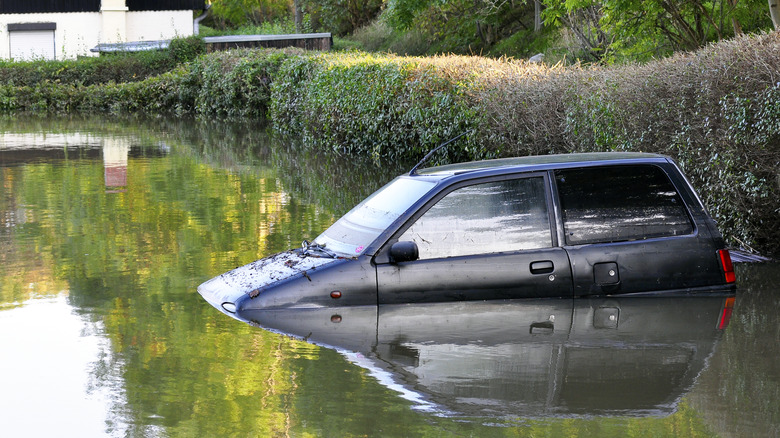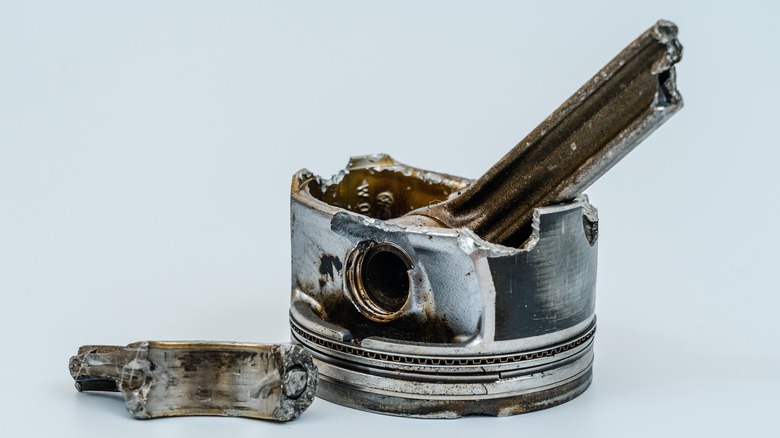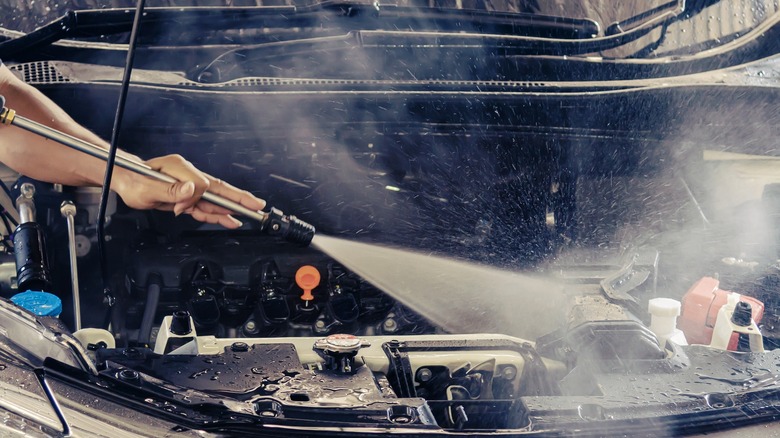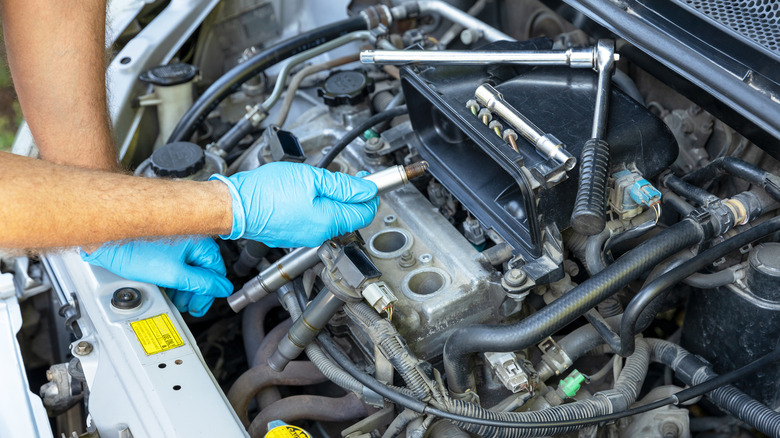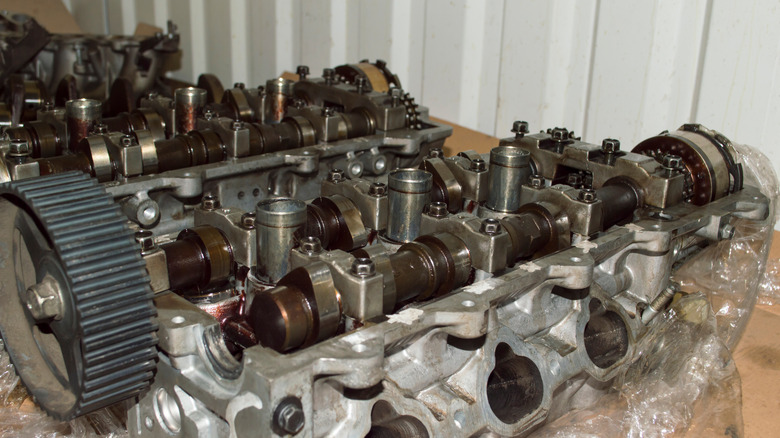Common Causes & Signs Of A Hydrolocked Engine
In my 35-plus years of driving and working on cars, I have encountered nearly every cause of engine failure, from bad habits that ruin the car engine to faulty oil pumps to ordinary mileage-related wear and tear. One of my shade tree mechanic gigs was repairing dozens of classic cars that were parked in a field in Chalmette, Louisiana that flooded during Hurricane Katrina in 2005. Water creeped into quite a few of their engines, causing damage that ranged from relatively inconsequential to catastrophic.
The owner of the stable of cars, a bear of a man who went by Big Dave, was fortunate in that all of his vehicles were parked when they were submerged. However, if water is introduced into an engine while it's running at high speeds, the consequences are almost always bad enough to require dropping in a rebuilt or remanufactured engine. Sometimes, the hydrolocking that occurs when this happens can even render the block and heads useless, which will require you to purchase a crate engine with all-new castings.
Hydrolocking is not only a danger if your car is caught in a once-in-a-generation flood while parked. Water can enter your engine if you try and drive through a deep puddle or across a flooded portion of roadway, or even while washing your car if you're not careful. Here's how to know if your engine has taken in water, and what you can do to prevent it from happening.
Hydrolocking can bend or break connecting rods
Your car's engine generates vacuum as the pistons move within the cylinders. Under normal conditions, this vacuum is used to mix air with fuel, enabling the combustive reaction that drives your engine's crankshaft. When water gets in the cylinders, the pistons are unable to compress it as they would air and fuel. If the engine is turning fast enough, the resulting counter-pressure can bend or break the connecting rods or destroy engine bearings. If this happens, your car will immediately conk out with a chorus of unmistakable metal-on-metal noises, and the broken rod can even be thrown through the oil pan or cylinder heads at high speed. If this happens at idle speed, the engine might simply seize instead of suffering a loud, catastrophic mechanical failure. If you suspect your engine is hydrolocked, turn your vehicle off immediately and call a tow truck.
The easiest way to prevent this from happening is to avoid driving through deep water under any circumstance. This advice can save you from more than a hydrolocked engine. Severe storms can cause fast-moving floodwater to breach roadways, and six inches of moving water is enough to make you lose control of your vehicle. A foot will completely float most cars, and a couple of feet is enough to sweep trucks and SUVs downstream. It's not worth risking your life to save a few minutes. If you encounter moving water on a roadway, turn around and find a safe detour.
You can also get water in your engine while washing it
Although most cars have the air intake near the top of the engine, water can splash onto the intake from underneath, through the grille, or through a damaged hood seal. Engines that have been modified with an aftermarket cold air intake are especially vulnerable to taking on water, as sometimes these cone-type air filters are mounted at or near bumper height. Water can also end up in the air filter and intake if you spray your engine with a high-pressure hose while washing your car. If you need to wash your engine, use a spray bottle of degreaser and rinse it using a bucket and sponge or the low-pressure setting at a self-serve car wash bay, taking care to keep water away from the air intake.
If you frequently go off-roading and like to take the risk of driving across small, slow-moving streams, consider installing a vertical snorkel that moves the air intake point to a safe height several feet above the roadway. If you have an off-road ready SUV like a Jeep Wrangler or Ford Bronco, your owner's manual and dealership should be able to tell you what the safe water fording depth is for your model. That's not an invitation to drive into the nearest deep lake, though; you can still risk taking in water through cracks in the snorkel or leaky gaskets.
What do you do if you think your engine is hydrolocked?
The air intake isn't the only place liquid can get into your engine. Serious leaks in the head gasket can cause coolant to seep from the passages around the block to the insides of the cylinders, although the volume of fluid that can enter this way is usually less than what can come in through the air intake. If your car has been submerged above the air intake or you suspect a head gasket leak, you might not be doomed. Keep the engine revs as low as you can, and get your car parked as soon as possible.
If you're comfortable doing some troubleshooting work on your own, have it brought to your home; otherwise, tow it to a repair facility. If you want to have a go at it yourself, first drain the oil, taking notice of how much water or coolant is mixed in. Remove all of the spark plugs, which will allow you to turn the engine and expel some of the water from the cylinders. Try to do so by cranking the engine briefly. With the plugs out, the pressure that otherwise might bend or break a rod should be released through the open spark plug holes. If you notice a substantial amount of water has gotten into the engine, it's time to do some more work.
You can try draining water from your engine by removing some parts
Another thing to try at home if you feel capable is to drain water from the engine and let it dry out. To do so, first remove the intake manifold and cylinder heads and check for water damage. Remove the oil pan as well, allowing you to inspect the main bearings and lower ends of the connecting rods. Removing the valve covers will also allow you to inspect the rocker arms and upper reaches of the valvetrain. Leave everything disassembled so the engine can dry thoroughly. You can also spray WD-40 onto the exposed parts of your engine to help flush out excess water since it evaporates quickly.
With the engine disassembled, turn it by hand via the crankshaft damper pulley bolt and check to make sure everything is rotating as it should. If you feel the engine binding as you turn it slowly, this can be an indicator that the bearings, rods, or crankshaft need attention. This is also a good time to replace the gaskets between the mating surfaces of the components you've removed.
Once everything is back together and you've refilled the engine with oil, cross your fingers and try and start the engine again. If karma is with you, everything should run smoothly. If your engine is still sputtering, or you notice white smoke coming from the tailpipe, it's likely time to take it to a shop to be torn down and rebuilt.
